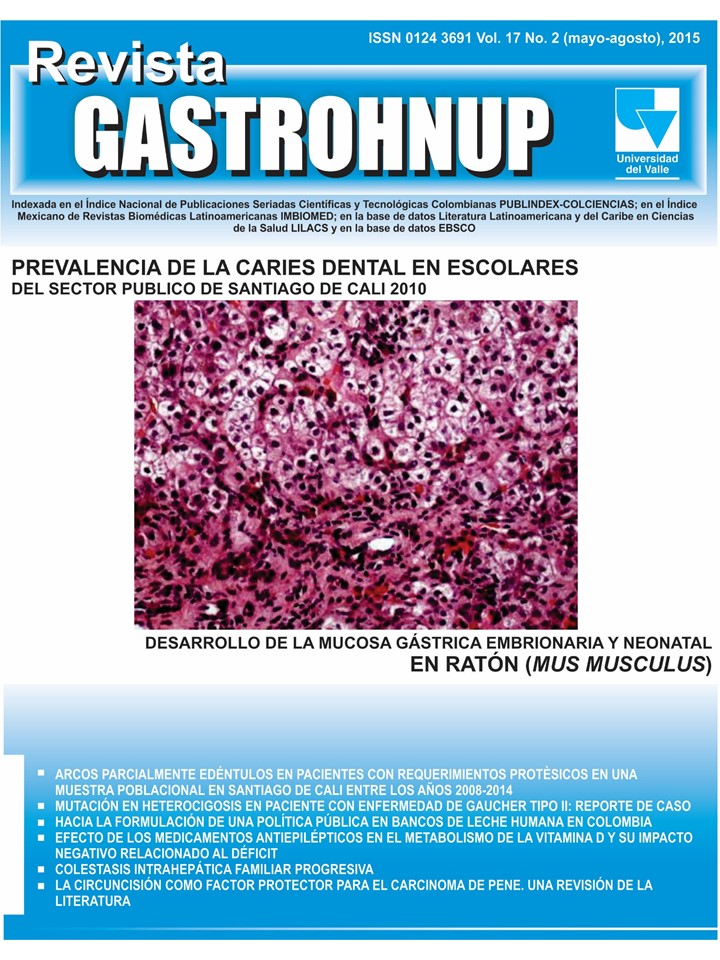DEVELOPMENT OF GASTRIC MUCOSA IN EMBRIONIC AND NEONATAL MOUSE (MUS MUSCULUS)
Main Article Content
Gastric cancer has a high prevalence worldwide. Due to
its multifactorial etiology, extensive and detailed
studies are required, in which murine models are key
for understanding the mucosa, site of most of the
carcinomas. Objective: To characterize the histology
of the gastric body mucosa of the mouse Mus musculus
in embryonic and neonatal stages. Methodology: 29
murine models where employed; 23 females and six
males in reproductive age, weighing between 20 and 30
grams. After mating, a total of 273 specimens were
obtained from gestational ages 15-18.5 days, and
postnatal ages 1-7 days and 15-24 days. The esophagus
and stomach were dissected, fixed, embedded in
paraffin, sectioned, and stained with hematoxylin and
eosin, Alcian Blue pH 2.5, and Periodic Acid-Schiff
(PAS). Results: At gestational age 15 days, the body
and fundus of the stomach can be discerned. A change
in the epithelium, from keratinized stratified squamous
to PAS-positive simple columnar, with short primitive
foveolae and few glandular buds within a thin lamina
propria, is appreciated. There is intense acidophilic
staining and vacuoles in the apical cytoplasm. At
postnatal age 1 day, a typical glandular organization is
observed. The PAS reaction remained stable during all
stages, both in the gastric pits and in the isthmus. From
postnatal age 18 days to 19 days, goblet-like cells
(PAS-positive) are seen in the limit between fundus and
body. At postnatal age 21 days, parietal and zymogenic
cells can be identified, and the amount of PAS-positive
cells decreases. Conclusion: The surface epithelium
of the mouse stomach is made up of a variety of cells,
some of which are absorptive, a cell line that is replaced
by mucous secretory cells when the glands mature.
Throughout the development of the gastric body
mucosa, the process of epithelial differentiation is
linked to mucin production.
its multifactorial etiology, extensive and detailed
studies are required, in which murine models are key
for understanding the mucosa, site of most of the
carcinomas. Objective: To characterize the histology
of the gastric body mucosa of the mouse Mus musculus
in embryonic and neonatal stages. Methodology: 29
murine models where employed; 23 females and six
males in reproductive age, weighing between 20 and 30
grams. After mating, a total of 273 specimens were
obtained from gestational ages 15-18.5 days, and
postnatal ages 1-7 days and 15-24 days. The esophagus
and stomach were dissected, fixed, embedded in
paraffin, sectioned, and stained with hematoxylin and
eosin, Alcian Blue pH 2.5, and Periodic Acid-Schiff
(PAS). Results: At gestational age 15 days, the body
and fundus of the stomach can be discerned. A change
in the epithelium, from keratinized stratified squamous
to PAS-positive simple columnar, with short primitive
foveolae and few glandular buds within a thin lamina
propria, is appreciated. There is intense acidophilic
staining and vacuoles in the apical cytoplasm. At
postnatal age 1 day, a typical glandular organization is
observed. The PAS reaction remained stable during all
stages, both in the gastric pits and in the isthmus. From
postnatal age 18 days to 19 days, goblet-like cells
(PAS-positive) are seen in the limit between fundus and
body. At postnatal age 21 days, parietal and zymogenic
cells can be identified, and the amount of PAS-positive
cells decreases. Conclusion: The surface epithelium
of the mouse stomach is made up of a variety of cells,
some of which are absorptive, a cell line that is replaced
by mucous secretory cells when the glands mature.
Throughout the development of the gastric body
mucosa, the process of epithelial differentiation is
linked to mucin production.
- Stomach
- Differentiation
- Morphological development of stomach
SALAZAR M, L. (2015). DEVELOPMENT OF GASTRIC MUCOSA IN EMBRIONIC AND NEONATAL MOUSE (MUS MUSCULUS). GastrohNup, 17(2). Retrieved from https://revistas.univalle.edu.co/index.php/gastrohnup/article/view/1391
Downloads
Download data is not yet available.
